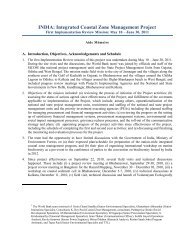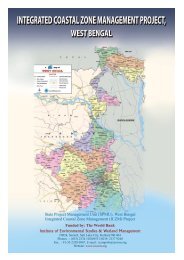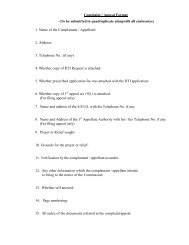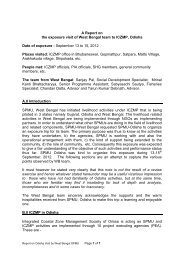Cyclone and Storm Surge - Iczmpwb.org
Cyclone and Storm Surge - Iczmpwb.org
Cyclone and Storm Surge - Iczmpwb.org
You also want an ePaper? Increase the reach of your titles
YUMPU automatically turns print PDFs into web optimized ePapers that Google loves.
6.12<br />
Hence, the crest level of the embankment facing of Bay of Bengal or the sea dyke = 5.40 m + 2.80<br />
m = 8.20 m<br />
Crest Width<br />
(a)<br />
For Major & Medium Rivers<br />
Based on "Urgent Development Works of Sundarban" the crest width of the proposed revetted<br />
embankment has been chosen as 3.00 m instead of 1.50 m (for only earthen embankment).<br />
(b)<br />
For Embankments facing Bay of Bengal<br />
As per the provision made in the "National Coastal Area Protection" Scheme, the crest width has<br />
been taken as 5.00 m.<br />
Riverside & Countryside Slope<br />
(a) For Major & Medium Rivers<br />
As per "Urgent Development of Sundarban Works Scheme, For major rivers the R.S. Slope is 4:1 For<br />
medium rivers the R.S. Slope is 3:1<br />
However, in this scheme for major rivers the R.S. Slope has been taken as 3:1 barring some<br />
embankments near Bay of Bengal where 4:1 slope has been adopted.<br />
In all the above cases, the countryside slope has been provided as 2:1.<br />
(b)<br />
For Embankments facing Bay of Bengal<br />
As per suggestion made in the "National Coastal Area Protection " Scheme, the riverside slope<br />
should be 6:1. However, for all practical purposes the same has been kept in this scheme as 5:1.<br />
Of course, the countryside slope will be 2:1 as usual.<br />
Revetment on Riverside Slope<br />
(a) For Major & Medium Rivers<br />
In all the embankments along major rivers the revetment work has been proposed to be done by 32.5<br />
cm thick dry brick pitching / 25 Cm thick brick pitching to be laid over 12.5 cm to 15.0 cm thick jhama<br />
khoa filter as has been provisioned in "Urgent Development Works of Sundarban Scheme executed<br />
earlier <strong>and</strong> the function of which has proved satisfactory.
















